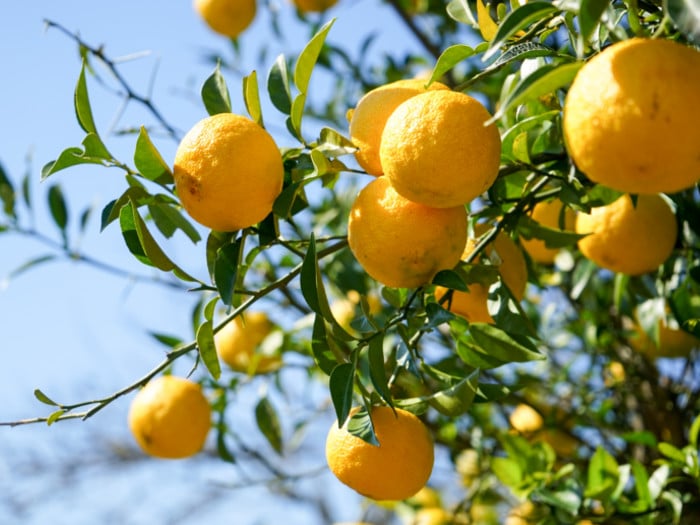The beginnings of yuzu juice are humble. The tiny citrus fruit started off in East Asia and till a few years ago, was an open secret in the culinary industry. Today, it is experiencing unprecedented popularity amongst the community of food connoisseurs around the world. A part of the reason is the growing availability of yuzu-based products around the world, and also the fact that enthusiasts are now experimenting with growing the fruit outside of its native region. However, it is the complex flavor of this fruit and the way it can be used to flavor several creations is why yuzu juice is having its moment in the sun.
Yuzu Fruit: History and Origins
The yuzu fruit is a small, yellow citrus fruit that is said to have originated in China, from where it propagated in Japan and Korea. The fruit, which is a cross between the mandarin orange and ichang papeda, can be visually described as an overgrown lemon or something close to a grapefruit. While some might grow to the size of a grapefruit, most remain the size of a golf ball. Today it is widely known for its use in Japanese cuisine. [1]

A single fruit yields about a teaspoon of yuzu juice. Photo Credit: Shutterstock
It has a fairly thick skin that turns from green to yellow when ripening and has an uneven texture. Ichang papeda, or Citrus ichangensis, has a hard and rough yet fragrant rind, which are some of the qualities that the yuzu takes from this fruit.
The yuzu fruit scent can be described as citrusy with a refreshing hint of floral. It is tart and light and less pungent than some other citrus fruits like grapefruits. Apart from the juice, the fruit is used for its zest. The flesh of the fruit is rarely eaten and almost all cultivation of the fruit finds use in culinary purposes as well as cosmetics. While the exquisiteness of yuzu juice has wowed many chefs, the yuzu flavor and fragrance is also a popular scent in hand creams, bath bombs, and lip balms. [2]
When you cut open a yuzu fruit, it looks almost dried and is full of seeds. One cannot expect more than a teaspoon full of yuzu juice from a single fruit. Thankfully, the flavor is concentrated in the juice and you do not need much for a single-use.
How to Use Yuzu Juice?
Yuzu juice is a yellow colored liquid, a little amount of which goes a long way. Owing to how little a single fruit yields, yuzu juice is billed expensive, even more so outside of the regions where it is grown.
But if you have a bottle of fresh yuzu juice with you and are wondering what to do with it, fret not. It is a versatile ingredient. Several recipes originally work with yuzu juice, bringing out its floral-citrus flavor. There are also some others that use yuzu juice as a preferred substitute for tangy ingredients such as vinegar or lemon juice.
Here are a few popular ways of using yuzu juice.
- Ponzu sauce: A soy-sauce based creation, ponzu sauce is used mainly in Japanese cuisine as a dressing or a dip. Speculated to have origins in the Dutch word pons, for punch, the recipe uses either yuzu juice or citrus options such as lemon or sudachi.
- Salad dressings: Chefs are coming up with newer recipes for salad dressings which incorporate the punch of yuzu juices and pair it with suitable salads. To begin with, you can experiment by adding in a bit of soy sauce and olive oil with a pinch of sugar and use this to dress your favorite salad.
- As a vinegar substitute: Yuzu juice gives a tang with a hint of floral aroma. So if you are looking to elevate the flavor profile of your dish, swap out the vinegar for this juice. Start by adding slowly as the zing can get overpowering.
- As a citrus substitute: Citrus juices like orange or tangerine tend to be sweeter than yuzu juice. By using the latter, you can make your marinades sharper and your dishes more vibrant.
- In cocktails: Yuzu juice has started featuring in several cocktails recently. You can make your own by tinging your vodka with it or using it instead of sourer alternatives.
These are some of the uses for yuzu juice. If you happen to have the fruit, it can be turned into a marmalade. The zest also adds more flavor to salads and dressings.
Adding to the taste is the health benefits of yuzu juice. A 2016 study published in the BioPsychoSocial Medicine journal found that the aroma of this fruit can improve parasympathetic nervous system activity by reducing negative emotional stress and mood disturbances in women during menstruation. People in Japan also use the fruit as an ambient addition for its aroma. [3]
Where to Buy Yuzu Juice?
Yuzu is a difficult fruit to grow even in its native regions, with the trees taking close to a decade to bear fruits. However, in an effort to have easy access to this fruit, several farms in warm areas and regions of higher demand, such as California, have started growing yuzu.
However, if you are looking to buy ready-to-use juice, you can find vendors online. While doing so, ensure you are buying it from trusted sources who have reliable user reviews and verified online presence. Alternatively, you can look for it in your local farmers’ market or marketplaces that deal in ingredients for Asian cuisine.
Yuzu juice has been a popular ingredient with chefs for a while now, so you might have had a taste already. The flavor and exoticness make it an interesting ingredient to work with. So don’t be afraid to experiment with it.
